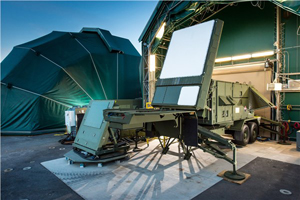Raytheon Company's newest integrated air and missile defense radar has accumulated more than 1,000 hours of operation, half the time of a typical testing program, since its debut at the 2016 Winter AUSA tradeshow.
Raytheon's proposed Patriot™ radar uses two key technologies: an active electronically scanned array (AESA) and GaN power amplifiers. The GaN-based AESA prototype routinely demonstrated 360-degree capability by working with a second GaN-based AESA antenna pointed in a different direction. As targets flew out of one array's field of view and into the other's, the two arrays seamlessly passed information back and forth, tracking the target continuously. The main array also detected and tracked tactically maneuvering fighter jets and thousands of other aircraft.
Raytheon's GaN-based AESA radar will work with the Integrated Air and Missile Defense Battle Command System and other open architectures. It maintains compatibility with the current Patriot Engagement Control Station and full interoperability with NATO systems.
A number of current and expected future Patriot Air and Missile Defense System partner nations in Europe and Asia have expressed interest in acquiring the GaN-based AESA. Poland submitted a letter of request on March 31. Raytheon's GaN-based AESA technology also meets Germany's requirements for the German Taktisches Luftverteidigungs System (TLVS), which is a tactical air and missile defense system.
"Raytheon's GaN technology is backed by 19 years of research and $300 million in investment, while our competitors are either new to the market or primarily build GaN for commercial applications," said Ralph Acaba, vice president of Integrated Air and Missile Defense at Raytheon's Integrated Defense Systems business.
"We achieved this milestone so quickly because of our successful experience developing and maturing GaN for programs like the U.S. Navy's Air and Missile Defense Radar," said Doug Burgess, director of AESA programs at Raytheon's Integrated Defense Systems business. "We're ready to take the next step and get this radar into the hands of our customers."

